What Is The World's Best Pig Breed For Meat?
Discover The World's Highest Quality Pig Breed For Meat

Pork, derived from pigs, is a cherished red meat in numerous cultures. This adaptable meat can be tailored to myriad culinary preferences.
Whether you prefer it succulent and tender or with a crispy finish, there's a best part of cuts and cooking method tailored for every preference. Aside from its nutritional benefits, pork elevates any dish's flavor and is a staple on charcuterie platters.
Globally, while numerous pig breeds exist, only a handful are renowned for their superior meat quality.
If you're keen on enhancing your meals with top-quality pork, exploring these six standout pig breeds is a must. Hailing from diverse regions, each breed boasts distinct attributes that make it a prime choice for meat consumption.
Discover the Top 6 Pig Breeds for Superior Meat Quality
1) Iberico (Spanish Pig)
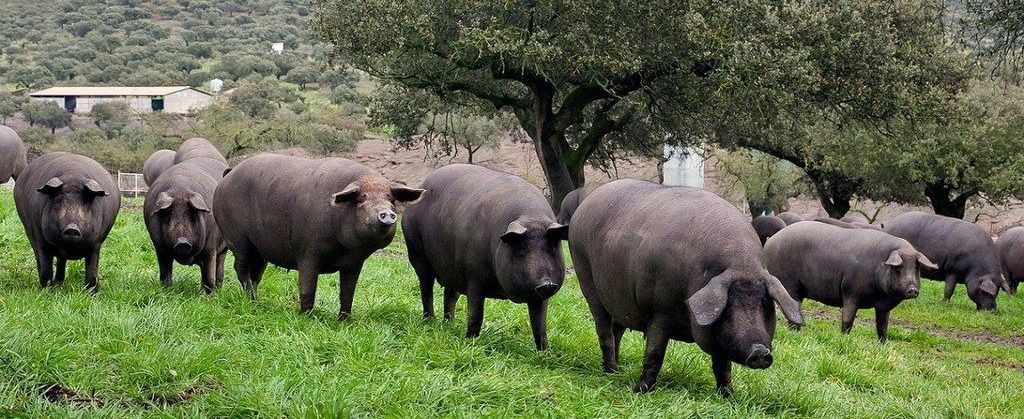
Iberico pork is a gourmet treasure. At first taste, you immediately recognize its unmatched flavor and tenderness. Its marble pattern, resembling streaks in red meat, promises a juicy bite, akin to butter.
A pure acorn-fed free-range Iberico pork leg, oftenly by dry-aged can fetch up to $4500, a testament to its luxurious quality. Spain's dedication to this meat is evident in its "Ruta del jamón ibérico," a route dedicated solely to selling Iberian pork products.
The raw meat's bright red hue might have you mistaking it for beef. Its complex flavor, influenced by its diet and environment, offers a blend of beef and pork tastes. Especially from acorn-fed breeds, you experience intense sweet and floral notes with a backdrop of nutty and earthy undertones, reminiscent of mildly salty parmesan cheese.
But what truly sets Iberico pork apart is its fat. The marbling, those delicate white flecks, indicates the highest quality. This fat ensures the ham's melt-in-the-mouth quality. A culinary experience unlike any other.
2) Kurobuta (Japanese Pig)
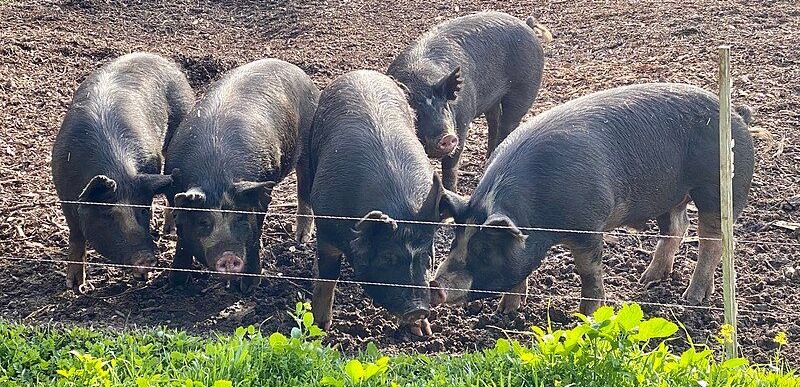
Kurobuta pork, revered globally for its exquisite taste, is derived from a special breed of hog: The Berkshire in England and the Kurobuta in Japan.
This unique pork's journey began in the 1860s when the first Berkshire hogs were gifted to Japanese emperors. Demand surged for this distinctive pork, leading to its Japanese name, "Kurobuta," which translates to "black hog".
While the origins of Kurobuta hogs trace back to the English Berkshire Pig, the meat's distinct flavors are influenced by regional variations in breeding and feeding. Unlike commodity hogs, which prioritize commercial traits like rapid growth, Kurobuta hogs are celebrated for their flavor and tenderness.
Kagoshima, Japan, is the renowned hub for Kurobuta pork production. This region, with its warm climate, adds its own twist by feeding the hogs sweet potatoes. The outcome? Pork that's supremely tender, generously marbled, and exudes a rich, sweet flavor profile.
It's especially loved in dishes like shabu-shabu or grilled preparations, as the meat's marbling possesses a high melting point.
To ensure authenticity and maintain its high reputation, Kurobuta Pork from Kagoshima is stringently managed. Each pig undergoes thorough certification to prevent imitation and guarantee quality.
3) Berkshire (English Pig)

Berkshire pigs, originally valued for their rich fat content especially in an era when lard was ubiquitous, saw a decline in popularity as the market shifted to favor leaner pork cuts. However, the modern culinary world's appreciation for heritage breeds has recently rejuvenated interest in Berkshire pigs within the U.S.
Dubbed the "wagyu of pork," Berkshire pork shares similarities with Wagyu beef, especially when it comes to marbling and tenderness.
This comparison becomes even more fitting considering that in Japan, the homeland of Wagyu beef, Berkshire pork is esteemed as Kurobuta pork and often commands a higher price.
This premium is not without reason. Based on assessments by the National Pork Board, Berkshire pork consistently outperforms in a plethora of categories. Among these are its: rich loin color, exceptional loin tenderness, prominent loin marbling, unparalleled taste across all categories and outstanding moisture retention when cooked.
A distinguishing characteristic of Berkshire pork is its darker color, attributed to an elevated pH level in the meat. This increased pH is linked to qualities such as tenderness, juiciness, and enhanced flavor.
In essence, for those seeking a pork cut that boasts flavor, succulence, and marbling, Berkshire pork stands out as an optimal choice.
4) Mangalica or Mangalitsa (Hungarian Pig)
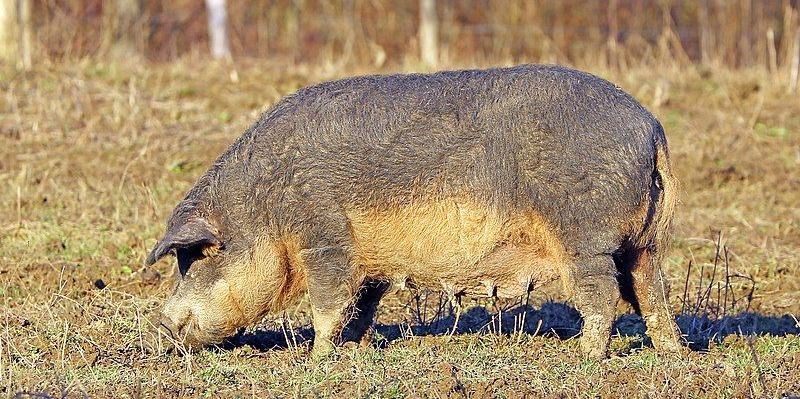
The Mangalitsa pig, a unique breed sporting a woolly sheep-like coat, has been affectionately dubbed the 'kobe beef of pork' due to its exceptional meat quality.
Originating from a 200-year-old Hungarian lineage, these curly-coated hogs, also referred to as Mangalica or Mangalitza, have recently experienced a remarkable revival.
Once teetering on the edge of extinction, they've become a culinary sensation, largely due to their intense flavor, high fat content, and richly marbled meat. These attributes starkly contrast the once-favored 'white' low-fat pork.
A crossbreed of the European wild boar and a close relative of the black-footed Iberian Pig, Mangalitsa incorporates prime qualities from both, making its meat highly versatile.
Notably, the Mangalitsa pork's high monounsaturated fat content makes it a prime candidate for charcuterie, from pancetta to salami. In cooking, the pork stands out for its tender and juicy meat that needs little seasoning.
Moreover, its unique lard, melting even at room temperature, offers a singular sensory delight. This characteristic is due to its fat profile: whereas common pork contains more polyunsaturated fats, Mangalitsa boasts a higher monounsaturated fat content, giving it a luxurious melt-in-the-mouth texture.
Even better, the breed generally contains less of the health-worrisome saturated fats compared to mainstream commercial breeds.
5) Duroc (U.S Pig)
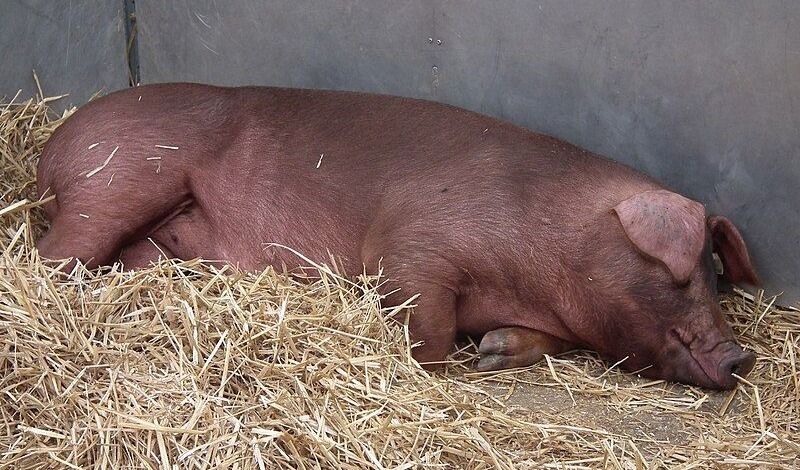
In recent years, the perception of pork has shifted. Once marketed as "the other white meat", there's a renewed appreciation for richer flavors, increased fat, and deeper colors in pork.
Consequently, chefs and gourmets are now turning their attention to specialty breeds celebrated for their juiciness and robust taste. Among these, the Duroc pig stands out and is particularly esteemed, not only for its meat but also as the choice breed for the renowned Culatello di Zibello.
Among the elite is the Duroc breed. Its origin traces back to Christopher Columbus, who introduced this distinct red hog to the Americas, noted for its rapid growth and mild demeanor. This unique lineage has been preserved across centuries.
In the 1800s, Harry Kelsey, a farmer, had an esteemed stallion named “DUROC.” Isaac Frink, a visiting cattleman, became enamored with Kelsey's standout red pigs. Given they lacked an official name, Frink named them "Duroc" in honor of Kelsey's stallion.
Today's Duroc pork signifies excellence, representing a mere top 2% of pork. Advanced processing methods, combined with the breed's inherent traits, yield pork with exceptional color and freshness. Renowned for its marbling and high intramuscular fat, Duroc pork offers a tender and juicy culinary experience.
Beyond its exquisite taste, it boasts a rich nutrient profile. Its meat is not only enriched with essential amino acids but also abundant in B vitamins.
Its nutritional qualities echo that of the Iberian pig, but with a leaner fat content. So, if you're in search of a delicious and nutritious pork cut, Duroc stands tall among its peers.
6) Jeju Island Black Pork (Korean Pig)
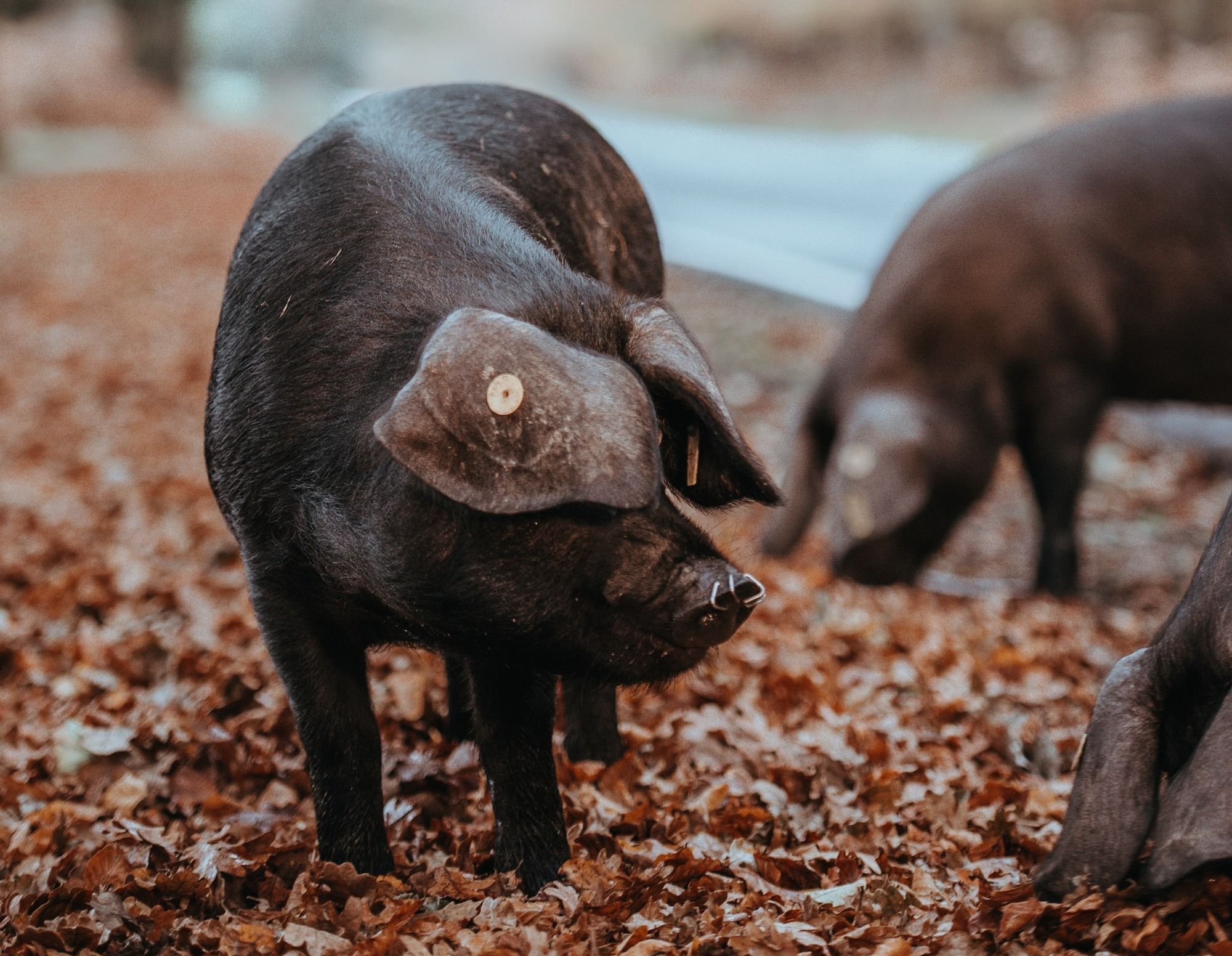
Korean cuisine, renowned for kimchi and hearty stews, also boasts the distinct Jeju black pig from Jeju Island. This black-haired pig, sometimes called the wagyu of pork, stands as a gastronomic icon in Korea.
With its origins dating back 2,000 to 3,000 years in Manchuria and breeding records in Korea from the 1400s, its historical significance is profound.
The Jeju black pig, named after its native Jeju Island off Korea's coast, holds a unique place in Korean culture and culinary traditions. Visitors from across Korea flock to Jeju just to savor this premium meat, considering a trip incomplete without tasting it.
Jeju black pig's standout features include its deep red, almost beef-like hue, a taste reminiscent of steak without the typical pork gaminess, and an unparalleled chewy texture. Its reddish tint and flavor profile, distinct from standard pale pink pork, have made it a prized delicacy.
When boiled, the meat strikes a perfect "baejigeun" balance of flavor and oiliness. Additionally, the pig's skin, known as "dwaeji ggupdaeg" in Korea, is cherished for its collagen content, believed to benefit human skin health.
In essence, the Jeju black pig is not just a meal but an embodiment of Jeju's rich history, culinary heritage, and a testament to Korea's reverence for quality and tradition in food.


